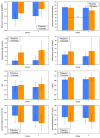Effects of cannabis on visual function and self-perceived visual quality
- PMID: 33462319
- PMCID: PMC7814053
- DOI: 10.1038/s41598-021-81070-5
Effects of cannabis on visual function and self-perceived visual quality
Abstract
Cannabis is one of the most used drugs of abuse in the world. The objective of this study was to analyze the effects of smoking cannabis on vision and to relate these to those perceived by the user. Thirty-one cannabis users participated in this study. Visual function assessment was carried out in a baseline session as well as after smoking cannabis. We evaluated static visual acuity, contrast sensitivity, stereoacuity, accommodative response, straylight, night-vision disturbances (halos) and pupil size. The participants were also divided into two groups depending on whether they perceived their vision to have worsened after smoking cannabis. A logistic regression analysis was employed to identify which visual test could best predict self-perceived visual effects. The study found that smoking cannabis has significant adverse effects on all the visual parameters analyzed (p < 0.05). Self-perceived visual quality results revealed that about two thirds of the sample think that smoking cannabis impairs their vision. Contrast sensitivity, specifically for the spatial frequency 18 cpd, was identified as the only visual parameter significantly associated with self-perceived visual quality (Odds Ratio: 1.135; p = 0.040). Smoking cannabis is associated with negative effects on visual function. Self-perceived visual quality after smoking cannabis could be related to impaired contrast sensitivity.
Conflict of interest statement
The authors declare no competing interests.
Figures




References
-
- European Monitoring Centre for Drugs and Drug Addiction (EMCDDA) European Drug Report 2019: Trends and Developments. Luxembourg: Publications Office of the European Union; 2019. p. 2019.
-
- Spanish Observatory on Drugs and Addictions . Survey on alcohol and drugs in Spain (EDADES), 1995–2017. Madrid: Ministerio de Sanidad, Consumo y Bienestar social; 2017.
Publication types
MeSH terms
Substances
LinkOut - more resources
Full Text Sources
Other Literature Sources
Medical

